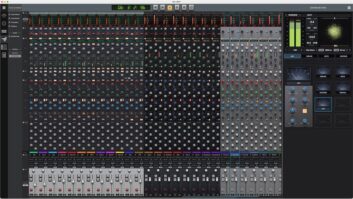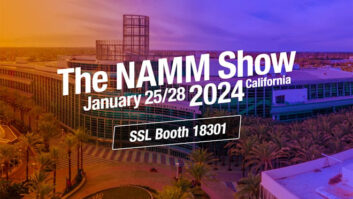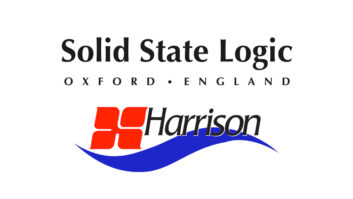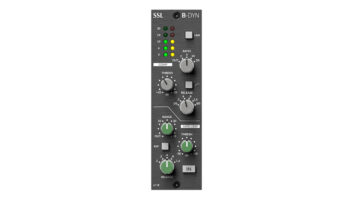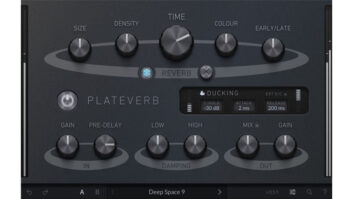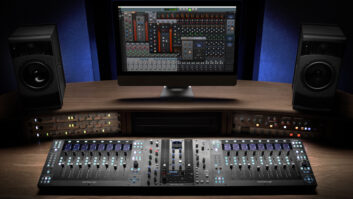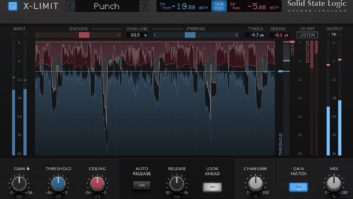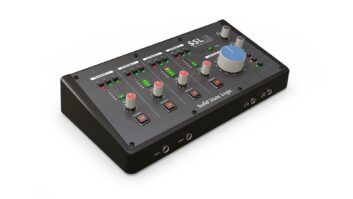SSL is known for breakthrough features and customization in the field, but can a mere one rack-space unit faithfully reproduce all those classic sounds.
Features
The front end of the E Signature Channel ($4,500) will accept line level signals (with a -20 dB to +20 dB trim pot), and takes in mic signals via one of two mic preamps (both sharing a common passive front end). Gain is offered from 20–70 dB here, with the usual complement of polarity reversal, phantom power and a 22 dB pad. The first preamp is transformer-coupled with a Jensen transformer faithful to the original E Series. The second preamp is electronically balanced and offers SSL’s Variable Harmonic Drive circuitry (VHD). This circuitry emulates vintage tube designs, but with the flexibility of selecting (or blending) second or third order harmonic distortion.
Signals are then routed to possibly the most sought after feature: the Listen Mic Compressor. Young‘uns will be fascinated to know that, back in the old days, clever techs would modify the compressor of the talkback section (the Listen Mic) to allow routing channel audio through it. This pumpy and aggressive compressor is notoriously respected for colorful mangling of drum room mics. The E Channel offers this function with only an “In” button and a simple “Less or More” pot. The amount of gain reduction is metered with a multicolor LED indicator.
The classic-styled compressor is next in line, with a minimum of extraneous features. Threshold, ratio and release rotary controls are offered with some important additional controls. One button will change the usual “over easy, soft knee” response to peak-sensing type if a “hard knee” characteristic is desired. The “Fast Attack” button reduces the unit’s typical 30 mS at 20 dB gain reduction to a quicker 3 mS at 20 dB reduction. The “Linear Release” button changes the typical logarithmic release to linear, as well as raising the threshold by 6 dB.
A noise gate is also found is this section, offering threshold, release and range controls. This processor block will function as a downward expander at lower ratios and can also be switched into fast attack mode.
A pair of filters is provided, just like in an E Series channel strip. These HPF and LPF filters usually exhibit a slope of 12 dB per octave, but can be affected by choices in the following “equaliser” section.
The EQ is four-band with a 6 dB per octave shelving section for both lows and highs (switchable to a fixed Q semi-parametric band) and two fully parametric bands for low-mids and high-mids. The mid bands employ SSL’s classic logarithmically symmetric design, which ensures that the 3 dB up or down points retain the same musical interval from center frequency, regardless of amplitude or frequency selected.
This already powerful EQ is now kicked into orbit with two flexible features. The first is “CT Out,” a switch that selects a common field mod often employed on the earliest ‘80s models. This circuitry defeats the typical non-interactive response between bands and introduces more interaction, as well as a slightly different gain law. The “BLK” switch employs circuitry that emulates the “Black Knob EQ” that was originally designed in 1983 with the help of George Martin. The “Black” EQ has enhanced range (+18 dB, not the +15 dB in the Brown EQ), a different control law, and steeper frequency slopes of the filters (18 dB per octave). The Black EQ is globally selected for all four EQ bands, whereas the “CT Out” button is found independently on each of the four bands.
In Use
My first test was very aggressive, yelled rap vocals. The preamp was clean and offered boatloads of gain, but the VHD was a bit too much on such inherently dirty tracks. The compressor was smooth and unobtrusively reduced gain without pumping or dullness. This track didn’t require EQ, but the HPF was quite necessary and, in a word, elegant. Yes, elegant; imagine filtering out all rumble with nary a ripple around the filter point or any of that mild yet veiling distortion found in typical HPFs. The vocal tracks were quite full-bodied and solid sounding, but still pleasantly defined and crisp without seeming strident.
Next up was the test you’ve all been waiting for: the drum ambience test. I applied an AEA R92 ribbon mic here, about 12 feet above and in front of a rock drum kit. I went with the normal mic preamp — and again, no VHD — but put the “Listen” in line. This modern “talkback compressor,” just like its esteemed forefather, gladly squeezed and pumped the kit beyond recognition. I backed off until it was no longer readily apparent and then split the difference. The result: a drum room track that is loaded with aggressive detail, but unfaltering in its lack of dynamics. Beautifully trashy, one might say (with a British accent, of course).
I finally got to apply the unit on some guitar overdubs. Electric guitar tracks, in my humble opinion, will often show a mic preamp’s inherent nonlinearity, often in unflattering ways. The E Channel really shined here, again. The E Channel neutrally applied gain, elegantly filtered out unwanted bottom and allowed me to add more “grunge” or “grit” with the VHD — whether I selected an Audio-Technica AT4033 condenser, a Shure SM57 or the AEA R92. This time around I found myself playing with the VHD to taste, sparingly applying it to tracks that were already a little dirty from their tube amp source. I later found the VHD to be useful on sung vocals as well.
More strident testing with program material revealed the versatility of the EQ section. The Brown EQ was quite pleasant, transparent and well behaved: just as you remember it. The Black EQ was more aggressive, more potentially powerful and seemed to offer a bit more “character”: just as you remember it. The “CT Out” controls are typically subtle in their differences. This feature is not readily apparent until you EQ with two overlapping bandwidths, where it becomes an important tool in sculpting the crossover points of your EQ curves.
Summary
This unit is simply stunning in its power, flexibility and sound quality. It took whatever I threw at it gracefully and met my expectations. This is no compromised, downscaled piece (nor what some might consider “affordable”).
It is a way, however, to get classic ‘80s console sounds right in your rack. My complaints are few and trivial — limited metering, minimal labeling and a tightly packed front panel — and are mostly associated with all this hardware being packed into only one rack space. This is a modern masterpiece, quibbles aside, that performs the magic that plug-ins are hard-pressed to touch.
Fast Facts
Applications
Vocal and instrument tracking, drum ambience tracking, processing pre-recorded tracks
Key Features
Single-channel; Variable Harmonic Distortion; Listen Mic Compressor; switchable Brown or Black E Series EQ
Price
$4,500
Contact
Solid State Logic | 212-315-1111 | www.solid-state-logic.com
Product Points
Plus
- VHD
- Listen Mic Compressor
- Excellent filters
- Super-flexible EQ
Minus
- Limited metering
- Crowded front panel
- Isn’t cheap
Score
The production hues of the 1980s are back, so there’s no better time than now to examine Solid State Logic’s new rack-mounted version of the classic E Series desks.
